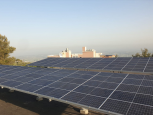Optimizing energy production requires a deeper understanding of the tilt angle of solar panels as it is very important. Effectiveness and output of solar panels is dependent on the angle of painting. In this blog, we’ll look into considerations of energy output of solar panels, the significance of tilt angle and how it can be maximized.
The tips for tilt angle of solar panel
Tilt angle is defined as the angle of the solar panel installed in relations to the ground level to which the panel is at. This angle determines how the panels can be exposed to sunlight and how and if is diffused. An optimal tilt angle enables solar panels to capture the sunlight and thus increase energy production. It is estimated that solar panels are more efficient when the tilt angle is adjusted with the location and seasons and thus can increase efficiency by more than 25%.
Factors Influencing Optimal Tilt Angle
The location and climatic conditions of an area contribute to determining the optimal tilt angle for solar panels. Latitude is one of the primary factors. In higher latitudes, solar panels should be installed at a steeper angle to maximize sunlight capture, especially during the winter months. In lower latitudes, a more horizontal angle might be better. Weather conditions, such as cloud cover and rainfall, also influence the tilt angle to capture solar rays effectively.
Seasonal Adjustments for Maximum Efficiency
Changing seasons impacts the position of the sun in the sky, and as a result, the angle of sunlight striking solar panels. Summer sunlight is at a higher angle, and in winter, the sun is lower in the sky. Adjusting the tilt angle to be more vertical in winter and at a fixed angle during summer can significantly boost energy production. Winter adjustments will enhance energy output, especially in regions with distinct seasons.
Considerations Before Investing In A Solar Panel
While installing solar panels on a given building, the construction feature efficiency to the structure's stability and the ability to change tilt angles need to be considered. Solar panels, like any other structure, need to be fixed to enhance energy assimilation. Solar panels that can be relocated can be set to collect maximum energy throughout the year. Moreover, the south direction in the northern hemisphere plays a crucial role in collecting maximum stare. The alignment and tilt angles of the solar panels need to be done with precision to ensure optimal energy use.
Future Trends In Solar Panels
The constant advancement in technology, in particular, solar technology, has given rise to distinct innovative methods that can be employed to enhance the efficiency of the solar panels. There has been an ever-increasing demand to install automatic tracker systems. These trackers can significantly enhance the energy production efficiency as compared to fixed installations. Advancements in solar rules alongside other areas of design is helping to enhance the efficiency of solar panels. The new solar panels can capture stare energy at different angles, thus reducing the need for tilt precision.
To summarize, the angle of tilt for solar panels is one of the most important factors for maximizing productivity. When solar energy users implement strategies around tilt angle, they are better able to optimize their solar systems. Thankfully, the future of solar energy is bright as further advancements in technology will enable even greater utilization of solar energy.




